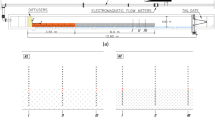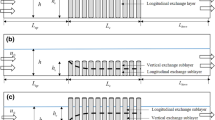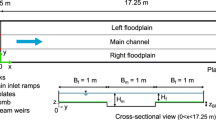Abstract
We report a semi-analytical theory of wave propagation through a vegetated water. Our aim is to construct a mathematical model for waves propagating through a lattice-like array of vertical cylinders, where the macro-scale variation of waves is derived from the dynamics in the micro-scale cells. Assuming infinitesimal waves, periodic lattice configuration, and strong contrast between the lattice spacing and the typical wavelength, the perturbation theory of homogenization (multiple scales) is used to derive the effective equations governing the macro-scale wave dynamics. The constitutive coefficients are computed from the solution of micro-scale boundary-value problem for a finite number of unit cells. Eddy viscosity in a unit cell is determined by balancing the time-averaged rate of dissipation and the rate of work done by wave force on the forest at a finite number of macro stations. While the spirit is similar to RANS scheme, less computational effort is needed. Using one fitting parameter, the theory is used to simulate three existing experiments with encouraging results. Limitations of the present theory are also pointed out.












Similar content being viewed by others
Notes
Thanks to suggestions by Drs. Benlong Wang and Xiaoyu Guo of Shanghai Jiao Tong University, China.
References
Asano T, Deguchi H, Kobayashi N (1992) Interactions between water waves and vegetation. Proc 23th Int Conf Coast Eng ASCE 3:2710–2723
Augustin LN (2007) Laboratory experiments and numerical modeling of wave attenuation through artificial vegetation. MS Thesis, Texas A &M University
Augustin LN, Irish JL, Lynett P (2009) Laboratory and numerical studies of wave damping by emergent and near-emergent wetland vegetation. Coast Eng 56:332–340
Cheng N-S, Nguyen HT (2011) Hydraulic radius for evaluating resistance induced by simulated emergent vegetation in open-channel flows. J Hydraul Eng 137:995–1004
Dalrymple RA, Kirby JT, Hwang PA (1984) Wave refraction due to areas of energy dissipation. J Waterw Port Coast Ocean Eng 110:67–79
Dubi A, Tørum A (1994) Wave damping by kelp vegetation. Proc 24th Int Conf Coast Eng ASCE 1:142–156
Fonsecaa MS, Cahalanb JA (1992) A preliminary evaluation of wave attenuation by four species of seagrass. Estuar Coast Shelf Sci 35:565–576
Harada K, Imamura F (2005) Effects of coastal forest on tsunami hazard mitigation—a preliminary investigation. In: Satake K (ed) Tsunamis: case studies and recent development. Advances in natural and technological hazards research, vol 23. Springer, Dordrecht, pp 279–292
Hiraishi T, Harada K (2003) Greenbelt tsunami prevention in south-Pacific region. Rep Port Airpt Res Inst 43:1–23
Huang Z, Yao Y, Sim SY, Yao Y (2011) Interaction of solitary waves with emergent rigid vegetation. Ocean Eng 38:1080–1088
Huang ZH, Zhang WB (2011) Wave attenuation through an array of rigid circular cylinders: a laboratory study. Asian Pac Coasts 2011:1826–1833
Kobayashi N, Raichlen AW, Asano T (1993) Wave attenuation by vegetation. J Waterw Port Coast Ocean Eng 199:30–48
Li CW, Yan K (2007) Numerical investigation of wave–current–vegetation interaction. J Hydraul Eng 133:794–803
Liu D, Diplas P, Fairbanks JD, Hodges CC (2008) An experimental study of flow through rigid vegetation. J Geophys Res 113:F04015. doi:10.1029/2008JF001042
Lowe RJ, Koseff JR, Monismith (2005) Oscillatory flow through submerged canopies: 1. Velocity structure. J Geophys Res 110:C10016. doi:10.1029/2004JC002788
Massel SR, Furukawa K, Brinkman RM (1999) Surface wave propagation in mangrove forests. Fluid Dyn Res 24:219–249
Mazda Y, Kobashi D, Okada S (2005) Tidal-scale hydrodynamics within mangrove swamps. Wetl Ecol Manag 13:647–655
Mazda Y, Wolanski E, King B, Sase A, Ohtsuka D, Magi M (1997) Drag force due to vegetation in mangrove swamps. Mangrove Salt Marsh 1:193–199
Mei CC, Stiassnie M, Yue DKP (2005) Theory and applications of ocean surface waves. Part I: Linear aspects. Eq. (9.2.16). World Scientific, Singapore, p 458
Mei CC, Black JL (1969) Scattering of surface waves by rectangular obstacles in waters of finite depth. J Fluid Mech 38:499–511
Mei CC, Chan I-C, Liu PL-F, Huang Z, Zhang W (2011) Long waves through emergent coastal vegetation. J Fluid Mech 461:461–491
Mendez FJ, Losada IJ (1999) Hydrodynamics induced by wind waves in a vegetation field. J Geophys Res 104:18383–18396. doi:10.1029/1999JC900119
Mendez FJ, Losada IJ (2004) An empirical model to estimate the propagation of random breaking and nonbreaking waves over vegetation fields. Coast Eng 51:103–118
Mo W (2010) Numerical investigation of solitary wave interaction with group of cylinders. Ph.D. Thesis, Cornell University
Morison JR, O’brien MP, Johnson JW, Schaaf SA (1950) The force exerted by surface waves on piles. Petrol Trans 189:149–154
Nepf HM (1999) Drag, turbulence, and diffusion in flow through emergent vegetation. Water Resour Res 35:479–489
Raupach MR, Shaw RH (1982) Averaging procedures for flow within vegetation canopies. Bound Layer Meteorol 22:79–90
Sarpkaya T, Isaacson M (1981) Mechanics of wave forces on offshore structures. Van Nostrand Reinhold, New York
Schutten J, Dainty J, Davy AJ (2004) Wave-induced hydraulic forces on submerged aquatic plants in shallow lakes. Ann Bot 93:333–341
Smagorinsky J (1963) General circulation experiments with the primitive equations. I. The basic experiment. Mon Weather Rev 91:99–164
Spalart PR, Allmaras SR (1994) A one-equation turbulence model for aerodynamic flows. La Recherche Aérospatiale 1:5–21
Stoesser T, Kim SJ, Diplas P (2010) Turbulent flow through idealized emergent vegetation. J Hydraul Eng 136:1003–1017
Stratigaki V, Manca E, Prinos P, Losada IJ, Lara JL, Sclavo M, Amos CL, Cáceres I, Sánchez-Arcilla A (2011) Large-scale experiments on wave propagation over Posidonia oceanica. J Hydraul Res 49:31–43
Strusińska-Correia A, Husrin S, Oumeraci H (2013) Tsunami damping by mangrove forest: a laboratory study using parameterized trees. Nat Hazards Earth Syst Sci 13:483–503
Sumer BM, Fredsøe J (2006) Hydrodynamics around cylindrical structures. World Scientific, Singapore
Tanino Y, Nepf HM (2008) Lateral dispersion in random cylinder arrays at high Reynolds number. J Fluid Mech 600:339–371
Trowbridge J, Madsen OS (1984) Turbulent boundary layers: 1. Model formulation and first-order solution; 2. Second-order theory and mass transport. J Geophys Res 89(7989–7997):7999–8007
Tschirky P, Hall K, Turcke D (2000) Wave attenuation by emergent wetland vegetation. Proc 27th Int Conf Coast Eng ASCE 3:865–877
Vo-Luong P, Massel S (2008) Energy dissipation in non-uniform mangrove forests of arbitrary depth. J Marine Syst 74:603–622
Wallace S, Cox R (2000) Effects of seagrass on nearshore current and wave dynamics. Proc 27th Int Conf Coast Eng ASCE 4:878–890
Wu W et al (2011) Investigation of surge and wave reduction by vegetation. SERRI Report 80037–01. U.S. Department of Homeland Security
Wu W, Zhang M, Ozeren Y, Wren D (2013) Analysis of vegetation effect on waves using a vertical 2D RANS model. J Coast Res 29:383–397
Zhong Z, Dai Y, Mei CC, Tong P (2002) A micromechanical theory of flow in pulmonary alveolar sheet. Comput Model Eng Sci 3:77–86
Acknowledgments
This work is supported by research grants from the National Science Foundation to Cornell University. CCM was also funded by a Mary Upson visiting professorship from Cornell University.
Author information
Authors and Affiliations
Corresponding author
Appendix: A constant eddy viscosity model for wave scattering by a finite forest belt
Appendix: A constant eddy viscosity model for wave scattering by a finite forest belt
For checking the numerical solution for variable \(M\) and \(N\) (see §7.1), we give the analytical solution for constant eddy viscosity.
The formal solutions in incidence zone and transmission zone are given by (7.2) and (7.3), respectively. For constant eddy viscosity in the forest region, \(M\) and \(N\) are complex constants. By separation of variables as for the open waters we obtain
where \(\gamma =\sqrt{(n+N)/(n+M)}\) and \(\hat{k}_q\) are complex roots of the transcendental equation
Note that boundary conditions (6.14) and (6.15) have been used. \(C_q\) and \(D_q\) are coefficients to be determined.
Coefficients \(B_p\), \(C_q\), \(D_q\), and \(E_p\) are to be determined by matching the pressure and the horizontal velocity component at the interfaces between two adjacent regions. At \(X=0\), the interfacial conditions are
At \(X=L_B\),
The following condition of orthogonality applies to both \(k_p\) and \(\hat{k}_q\):
where \(\kappa =k\) or \(\hat{k}\). By truncating the series and using (A.7) in (A.3) and (A.6), we obtain
at \(X=0\), and
at \(X=L_B\), where
In addition, \(P_r\), \(Q\), and, \(P_t\) are the finite terms after truncation in zones (I), (F), and (T), respectively. The expansion coefficients \(\left( B_p,C_q,D_q,E_p\right) \) can now be obtained by solving numerically the above algebraic equations. Afterwards, \(|R|=|B_0|\) and \(|T|=|E_0|\) are the reflection and transmission coefficients respectively.
Rights and permissions
About this article
Cite this article
Mei, C.C., Chan, I.C. & Liu, P.L.F. Waves of intermediate length through an array of vertical cylinders. Environ Fluid Mech 14, 235–261 (2014). https://doi.org/10.1007/s10652-013-9308-1
Received:
Accepted:
Published:
Issue Date:
DOI: https://doi.org/10.1007/s10652-013-9308-1




